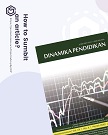The Analysis of Factors Influencing Financial Technology Usage in Higher Education
(1) Universitas Indraprasta PGRI Jakarta
(2) Universitas Indraprasta PGRI Jakarta
(3) Universitas Indraprasta PGRI Jakarta
Abstract
This study aims to analyze and to shape the factors that influence the use of financial technology, especially among students, because recently the financial technology usage among students increased slightly in the previous year. This increase was influenced by several factors that have not been classified. The population consisted of 1,229 students of the Indraprasta University PGRI Jakarta, with 273 students as the sample obtained using simple random sampling. Techniques of data collection used a questionnaire with a Likert scale consisting of seven points. Techniques of data analysis used factor analysis from software Statistical Package for the Social Science version 24.0. The results of the factor analysis show that eight factors are formed from several variables, with a contribution of 65.368%. While 34,632% is explained by other not examined factors, these factors consist of security, product offered, access and profit, loyalty, information, facility, demand and quality. For future research, it needs to test and analyze factors formed to add references of science and technology, especially in the field of financial technology.
Keywords
Full Text:
PDFReferences
Abidin, S. N. L. B. Z., & Yaacob, M. H. Bin. (2020). Faktor-Faktor yang Mempengaruhi Penggunaan Fintech dalam kalangan Pengguna di Malaysia, 4(March), 1–13.
Alwi, A. B. (2018). Pembiayaan Berbasis Teknologi Informasi (Fintech) yang Berdasarkan Syariah. Al-QÄnÅ«n, 21(2), 255–271. Retrieved from https://katadata.co.id/berita/2017/08/28/bi-
Amalia, S. N. A. (2018). Faktor-Faktor Yang Mempengaruhi Minat Individu Terhadap Financial Technology Syariah Paytren Sebagai Salah Satu Alat Transaksi Pembayaran: PendekatanTechnology Acceptance Model dan Theory Of Planned Behavior. Iqtishaduna, 9(1), 64–79.
Ansori, M. (2019). Perkembangan dan Dampak Financial Technology (Fintech) terhadap Industri Keuangan Syariah di Jawa Tengah. Wahana Islamika: Jurnal Studi Keislaman, 5(1), 31–45.
Arner, D., Barberis, J., & Buckley, R. (2015). The Evolution of FinTech: A New Post-Crisis Paradigm?, 0–45.
Buckley, R. P., & Webster, S. (2016). Customer Relationship Management Capabilities: Measurement, antecedents and consequences’, 2012 (50)1 Management Decision 115. Journal of Financial Transformation, 44(2016), 117. Retrieved from https://www.bcgperspectives.com/content/articles/financial-institutions-
Burhanuddin, C. I., & Abdi, M. N. (2019). Tingkat Pemahaman dan Minat Masyarakat dalam Penggunaan Fintech. RISET & JURNAL AKUNTANSI, 3(1), 21–27.
Chai, S., Kim, M., & Rao, H. R. (2011). Firms' information security investment decisions: Stock market evidence of investors' behavior. Decision Support Systems, 50(4), 651-661.
Chen, K. (2018). Financial Innovation and Technology Firms: A Smart New World with Machines. International Symposia in Economic Theory and Econometrics, 25, 279–292. https://doi.org/10.1108/S1571-038620180000025012
Chen, M. A., Wu, Q., & Yang, B. (2019). How valuable is FinTech innovation?. The Review of Financial Studies, 32(5), 2062-2106.
Demertzis, M., Merler, S., & Wolff, G. B. (2017). Capital Markets Union and the fintech opportunity Bruegel.
Gai, K., Qiu, M., & Sun, X. (2017). A Survey on FinTech. Journal of Network and Computer Applications, 1–59. https://doi.org/10.1016/j.jnca.2017.10.011
Gai, K., Qiu, M., & Sun, X. (2018). A survey on FinTech. Journal of Network and Computer Applications, 103, 262–273. https://doi.org/10.1016/j.jnca.2017.10.011
Gai, K., & Steenkamp, A. L. (2014). A Feasibility Study of Platform-as-a-Service Using Cloud Computing for a Global Service Organization. Journal of Information Systems Applied Research, 7(3), 28–42.
Gregor Dorfleitner, J., Hornuf, L., Schmitt, M., & Weber, M. (2016). FinTech- Markt in Deutschland.
Grzywacz, J., & Jagodzińska-Komar, E. (2018). Rola Banków I Sektora Fintech W Świetle Implementacji Dyrektywy Psd2, 159–169.
Gai, K., Qiu, M., & Elnagdy, S. A. (2016). A novel secure big data cyber incident analytics framework for cloud-based cybersecurity insurance. In 2016 IEEE 2nd International Conference on Big Data Security on Cloud (BigDataSecurity), IEEE International Conference on High Performance and Smart Computing (HPSC), and IEEE International Conference on Intelligent Data and Security (IDS) (pp. 171-176). IEEE.
Gai, K., & Steenkamp, A. (2013). Feasibility of a Platform-as-a-Service implementation using cloud computing for a global service organization. In Proceedings of the Conference for Information Systems Applied Research ISSN (Vol. 2167, p. 1508).
Hadad, M. D. (2017). Financial Technology (Fintech) di Indonesia. Kuliah Umum tentang Fintech, Indonesia Banking School.
Haddad, C., & Hornuf, L. (2019). The emergence of the global fintech market: Economic and technological determinants. Small Business Economics, 53(1), 81-105.
Kefela, G. T. (2010). Promoting access to finance by empowering consumers-Financial literacy in developing countries. Educational research and reviews, 5(5), 205.
Korkiakoski, E. (2017). Fintech-Yritysten Tarjoamien Vertaislainapalveluiden Käyttö Rahoituksessa Ja Sijoittamisessa.
LEE, D. K. C., & TEO, E. G. S. (2015). Emergence of FinTech and the LASIC Principles.
Luckandi, D. (2018). Analisis Transaksi Pembayaran Menggunakan Fintech Pada UMKM di Indonesia : Pendekatan Adaptive Structuration Theory.
Milian, E. Z., Spinola, M. de M., & Carvalho, M. M. d. (2019). Fintechs: A literature review and research agenda. Electronic Commerce Research and Applications, 34(September 2018). https://doi.org/10.1016/j.elerap.2019.100833
Moon, W. Y., & Kim, S. D. (2017). Adaptive fraud detection framework for fintech based on machine learning. Advanced Science Letters, 23(10), 10167-10171.
Mooslechner, P. (2017). The FinTech Revolution : More important than the ATM ?
Navaretti, G. B., Calzolari, G., & Pozzolo, A. F. (2017). Fintech and banking. friends or foes? European Economy: Banks, Regulation, and the Real Sector.
Park, J. H., & Park, J. H. (2017). Blockchain security in cloud computing: Use cases, challenges, and solutions. Symmetry, 9(8), 1–13. https://doi.org/10.3390/sym9080164
Rahmawati, L., Badriati, B. El, & Tanjung, I. (2018). Analisis Permintaan dan Perilaku Konsumen Fintech Syariah Model Crowdfunding. Profit : Jurnal Kajian Ekonomi Dan Perbankan Syariah, 2(1), 35–49.
https://doi.org/10.33650/profit.v2i1.552
Rizal, M., Maulina, E., & Kostini, N. (2018). Fintech As One Of The Financing Solutions For SMEs. Jurnal Pemikiran Dan Penelitian Administrasi Bisnis Dan Kewirausahaan, 3(2), 89–100.
RomÄnova, I., & Kudinska, M. (2017). Banking and fintech: a challenge or opportunity? Contemporary Studies in Economic and Financial Analysis, 98, 21–35. https://doi.org/10.1108/S1569-375920160000098002
Sari, P. B., & Dwilita, H. (2016). Prospects Of Financial Technology (Fintech) In North Sumatra Viewed From The Side Of Financial Literacy, Financial Inclusion And Poverty. Kajian Akuntansi, 9–17.
Schindler, J. (2017). FinTech and Financial Innovation: Drivers and Depth. Finance and Economics Discussion Series Divisions of Research & Statistics and Monetary Affairs Federal Reserve Board , Washington , D . C ., 1–16.
Susilo, A. Z., Iksan Prabowo, M., Taman, A., Pustikaningsih, A., & Samlawi, A. (2019). A comparative study of factors affecting user acceptance of go-pay and OVo as a feature of Fintech application. Procedia Computer Science, 161, 876–884. https://doi.org/10.1016/j.procs.2019.11.195
Themen, A. (2014). Fintech – Die digitale (R) evolution im Finanzsektor.
Theodora, B. D., & Marti, S. (2016). The Effect of Family Economic Education towards Lifestyle Mediated By Financial Literacy. Dinamika Pendidikan, 11(1), 18–25. https://doi.org/10.15294/dp.v11i1.8697
Triwidisari, A., Nurkhin, A., & Muhsin, M. (2018). The Relationships Between Instagram Social Media Usage, Hedonic Shopping Motives and Financial Literacy on Impulse Buying. Dinamika Pendidikan, 12(2), 170–181. https://doi.org/10.15294/dp.v12i2.13565
Tsai, C., & Peng, K.-J. (2017). The FinTech Revolution and Financial Regulation : The Case of Online Supply-Chain Financing, (2015), 1–24. https://doi.org/10.1017/als.2016.65
Refbacks
- There are currently no refbacks.

This work is licensed under a Creative Commons Attribution 4.0 International License.


.png)

.png)





